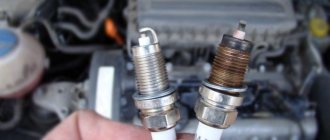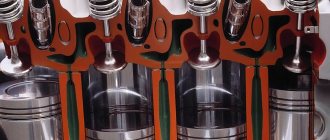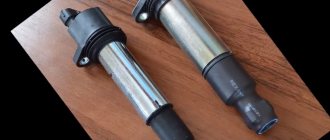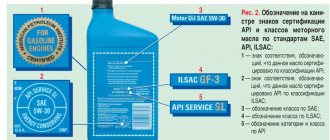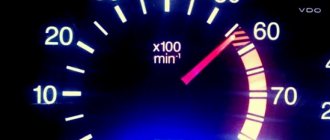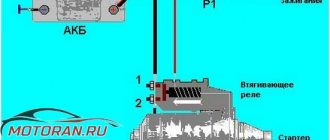Injector VAZ 2107: device and features | Everything about auto-moto-bicycle technology
In this article we will look at the VAZ-2107 car (injector). We will simply bypass carburetor models, since they have long been morally obsolete. As for injection engines (with forced injection of the fuel mixture), they are by far the most common. The modern automobile industry has completely abandoned carburetor systems. What elements are present in the injection system that are absent in the carburetor system? In this article we will try to find out.
How does a fuel injection system work?
The essence of the whole process is that gasoline is supplied under pressure into the fuel rail, in which it is mixed with purified air in a ratio of 14 to 1. The mixture is always under pressure, so when the valve opens, it enters the combustion chamber unhindered. Here ignition occurs and the piston makes a power stroke. At the same time, the crankshaft rotates and the car is set in motion.
A bunch of sensors are responsible for the normal operation of all components, which measure temperature, pressure, amount of air and gasoline, etc. All signals are sent to a microcontroller control unit. It contains a special algorithm that regulates the operation of all main components and mechanisms. This is what we will talk about the VAZ-2107 engine (injector) in our article. Or more precisely, about its components.
Crankshaft sensor
This is one of the important reading devices, available on any injection engine, including “sevens”. With its help, the number of revolutions of the crankshaft is read.
If you take a closer look at the design of the entire assembly, you can see that the sensor is installed opposite the teeth of the crankshaft pulley. And you can see that the distance between the teeth is the same, but not everywhere.
There is a gap in which two teeth are missing - it is this segment that is the “setter”. The sensor catches it and begins to count a new revolution of the pulley.
Using this device, the number of revolutions is recorded. Based on the data received from the sensor, the electronic control unit decides whether to increase or decrease the amount of air or gasoline in the mixture. But that’s not all, other devices also affect the work, which we will talk about later.
Air flow sensor
This is a device that allows you to record the amount of air that enters the fuel rail. The design is based on a platinum thread, which in some cases becomes dirty. To extend the life of this device, it is necessary to change the air filter in a timely manner. If the degree of contamination is small, it is possible to clean the thread using an injector cleaner.
The essence of the work is that the thread is heated to a certain temperature. When air passes through the tube, the thread cools by several degrees. The logic installed in the control unit calculates the amount of air that enters the ramp. This is the easiest way to count the air entering the ramp to form the mixture.
Speed sensor
This device measures the speed of a vehicle. Data is supplied not only to the electronic control unit, but also to the speedometer to inform the driver about the current speed. The device is placed directly on the top of the gearbox.
Camshaft sensor
It is installed, as the name suggests, on the camshaft. This is one of the devices with which you can set the correct ignition. The VAZ-2107 (injector) does not have a distributor; the spark is generated using logical elements based on data received from reading devices.
Ignition system
Carburetor engines had mechanical ignition distributors (both contactless and contact). But they all have one big drawback - friction is still present to a greater or lesser extent, so the reliability of the entire mechanism is low.
As for injection engines, all parameters are read using sensors. The signals are sent to the electronic control unit and then processed. The logic allows you to adjust the ignition timing and the timing of fuel injection into the combustion chamber. Spark plugs and armored wires are used exactly the same as on carburetor engines.
It is worth noting that modern cars are equipped with an ignition system in which a separate coil is installed on each spark plug and a low-voltage wire is connected to it. In this simple way we managed to avoid the presence of high voltage under the hood.
Damper position sensor
The throttle valve is a unit that allows you to change the amount of air supplied to the fuel rail. Essentially, when you press the accelerator pedal, you are increasing the amount of air, not gasoline. Based on how much oxygen enters the ramp, the volume of gasoline will increase or decrease. In total, you can find two types of sensor designs:
- Resistive.
- Contactless.
- You turn the ignition key, power is supplied to the electronic control unit, all sensors and actuators.
- After the crankshaft begins to rotate, the VAZ-2107 generator (injector) starts working with the starter.
- All sensors record changes in the parameters they measure.
- The electronic control unit adjusts the quality of the mixture and regulates the ignition timing.
- The mixture is fed under pressure into the combustion chambers through open nozzles, and the ignition process and working stroke begin.
The former are similar in principle to volume controls in household appliances. They have one big drawback - they have rubbing surfaces, so the device often fails. The development is usually present at the very beginning of the track. If the position sensor breaks down, there will be a frequent change in idle on the VAZ-2107 (the injector cannot understand what position the pedal is in, since the resistance of the sensor is unstable).
The contactless sensor does not have such disadvantages (it works on the encoder principle). But its cost is much higher, so ordinary drivers rarely install them on their cars.
Fuel injectors
These are one of the main components; their cleaning and replacement on the VAZ-2107 (injector) must be done in a timely manner. Filters also affect the life of injectors. Essentially, injectors are solenoid valves that stand in the way of the movement of the fuel mixture. The electronic control unit gives the command to open and close them, based on sensor readings.
To protect electrical circuits, fuses are installed in the mounting block. On the VAZ-2107 (injector), all components are protected, and the injectors must be turned on via an electromagnetic relay, since they have a high current consumption.
Fuel pressure sensor
This device is necessary to prevent high pressure from building up in the fuel rail. A pump located in the tank pumps gasoline through pipelines into the fuel rail to a certain pressure. It should be enough for the mixture to be injected into the combustion chamber.
The sensor is installed directly on the ramp, and if the maximum permissible pressure value is exceeded, the excess is released through a check valve into the line connected to the tank.
The operating principle is approximately the same as that of the expansion tank cap in the cooling system.
Lambda probe
This is a sensor that allows you to estimate the oxygen content in exhaust gases. It should be noted that direct measurements cannot be taken, so you have to install a sensitive element inside and outside the exhaust pipe. And to improve sensitivity, you need to warm up the device to 600 degrees.
This sensor sets the ignition timing and regulates the quality of the fuel mixture. The presence of the device is due to the introduction of toxicity standards.
THIS IS INTERESTING: How much oil should I put in g4kd?
How does the fuel injection system work?
Now let's talk about how the fuel injection system works. So, from the very beginning:
That's all - the engine has started, all its components are working. When you press the accelerator pedal, you increase the amount of air, and therefore gasoline. The crankshaft speed will also increase.
Source: https://westroad.su/avtomobili/legkovye/injektor-vaz-2107-ystroistvo-i-osobennosti
VAZ 2107 injector device - Do-it-yourself car repair
“Seven” is the latest representative of the VAZ series of rear-wheel drive cars. The seventh model was developed on the basis of the VAZ 2105 and differs in the shape of the seats, interior trim, shape of lighting devices and engine power.
Initially, the VAZ 2107 was equipped with a one and a half liter engine from the VAZ 2103. Subsequently, the range of engines installed on the “seven” was expanded. Cars with engine sizes ranging from 1.45 to 1.7 liters were produced for different markets. It was the 1.7 liter engine that was the first to be equipped not with a carburetor, but with an injection power system. Subsequently, the VAZ 2107 injector completely removed carburetor cars from the assembly line.
The principle of operation of the VAZ 2107 injection engine
Unlike carburetor systems, where the preparation of the air-fuel mixture occurs in the carburetor chambers, the injection system involves injecting fuel directly into the cylinders. Therefore, such a system is called a “distributed injection system”.
Injection systems are qualified depending on the principle of operation and the number of injectors. “Seven” is equipped with a separate injection system with 4 nozzles (one per cylinder). VAZ 2107 injectors are controlled by a microcontroller of the electronic engine control unit. It regulates the flow of fuel into the cylinders depending on the operating mode, the position of the gas pedal and other parameters read by special sensors.
The ECU (electronic control unit) controls the amount of fuel and air entering the engine combustion chambers. In addition, it controls the formation of a spark on the spark plugs, changing the timing depending on the speed. The ECU also turns the fuel pump on and off, regulates idle speed, controls the amount of CO in the exhaust gases, and the temperature of the coolant in the cylinder block. It all works as follows.
Gasoline from the tank, passing through the fuel filter, is supplied by a pump to the fuel rail. The latter has a pressure regulator that regulates the flow of fuel to the injectors. A pressure of 300 MPa is maintained in the fuel rail, and excess fuel is sent to the gas tank through the return pipe.
The electronic control unit opens and closes the injectors, ensuring that gasoline is supplied to the intake manifolds with each engine revolution. The amount of fuel entering the cylinder depends on the time during which the injector is open.
The ECU calculates this time based on the readings of many sensors. The main indicators that affect the injector opening time are information from the mass air flow sensor and the throttle position sensor.
The opening moment of the injector is determined based on the position of the pistons in the cylinder, which is transmitted to the ECU by the crankshaft sensor.
Other parameters are also taken into account:
Ignition system VAZ 2107 injector
The VAZ 2107 injection engine is equipped with an electronic ignition module, consisting of an electronic board and a pair of coils. Due to the absence of moving parts, the system is highly reliable and does not require regular maintenance. The moment of spark formation is determined by the engine ECU and depends on the crankshaft speed.
Advantages of VAZ 2107 injection models
- Due to the optimal formation of the fuel mixture, the efficiency of an injection engine is higher than that of a carburetor. Accordingly, the VAZ 2107 injector engine consumes less fuel and is at the same time more powerful than a carburetor engine with the same volume.
- Electronics regulate engine speed, thanks to which it idles more steadily, stalls less often when starting from a standstill, and starts better in cold weather.
- Unlike a carburetor engine, an injection engine does not require frequent adjustment of the fuel supply and ignition systems.
- The optimal composition and quantity of the fuel-air mixture entering the cylinders, as well as the presence of a catalyst, ensure a minimum content of harmful substances in the exhaust. This is an important point from an environmental and health perspective.
- Hydraulic chain tensioner and hydraulic valve clearance compensators eliminate the need for manual adjustment of the mechanism and ensure quieter engine operation.
- The torque curve is smoother - high torque is achieved over a wider rpm range.
Disadvantages of the injection model of the VAZ engine
In addition to its advantages, the injection VAZ 2107 has some disadvantages:
- The location of the engine and other units in the engine compartment remains the same as in the old-style “classic”. This makes it difficult to access some parts. However, the injection system is quite reliable, so it does not require frequent maintenance during operation.
- The injection “seven” is equipped with a catalyst, which is easily damaged when driving through obstacles. Therefore, you need to be careful when driving on uneven roads.
- An engine with an injector is more demanding on fuel quality than a carburetor variation. When using low-quality gasoline, the system may become contaminated, requiring unscheduled maintenance of the unit.
- If the injection system breaks down, it will not be possible to repair it and adjust it “on the knee” in a garage. You'll have to go to a service station.
Malfunctions of the VAZ 2107 injection engine
Problems with the 7 injection engine usually manifest themselves as follows:
- The engine is running erratically.
- Fuel consumption of the VAZ 2107 has been increased.
- There is an increased CO content in the exhaust gases.
- Dips when pressing the accelerator pedal.
- The engine “does not pull” (reduced power).
- To diagnose injection system faults, special equipment is required. In particular, in order to read error codes and check sensor readings and the operation of the engine ECU, a special computer (tester) is required. Therefore, repairs and diagnostics of the VAZ 2107 injector are carried out at specialized service stations. The most common cause of injector failure is clogged injectors.
Causes of injector clogging
Typically, problems with the injection system occur when using low-quality gasoline. Heavy paraffins contained in such fuel settle on the walls of the system, cutting off the fuel supply. Manufacturers of high-quality gasoline add detergent to it - a special additive that dissolves deposits. Low-quality gasoline contains too much paraffin, which forms deposits faster than detergents can remove them.
THIS IS INTERESTING: How much antifreeze is poured into the radiator?
Deposits form more intensively at low temperatures, so when the car is frequently driven with a cold engine, the injector becomes clogged more often.
Deposits can accumulate not only in the injectors. Often vapors settle on the throttle valve, which leads to a change in the proportions of the air-fuel mixture entering the cylinders.
Deposits of substances contained in low-quality gasoline may also appear on the back of the intake valve plates. This can lead to valve burnout or fuel detonation.
To clean the injection system of deposits, it is necessary to use special flushing fluid and equipment. You can wash the injector in a garage. To do this, you need a syringe and washing liquid.
The latter is mixed with gasoline and poured into the injection system through the hose of the vacuum brake booster. First, the operation is performed with the engine turned off, then with the engine running. The mixture is fed into the running engine gradually, in small portions.
As a result, the deposits dissolve, enter the engine cylinders and burn there. In this case, clouds of smoke may briefly appear coming out of the muffler.
Source: https://avto-voshod.ru/ekspluatatsiya/ustrojstvo-vaz-2107-inzhektor.html
Let's sum it up
Listed above are the most common reasons why the engine stalls on gas. At the same time, there are also a number of other failures and breakdowns that lead to uneven operation of the engine at idle, under load, “cold” or “hot”. Often, without the proper experience and professional equipment, it is quite difficult to eliminate a non-obvious cause with your own hands.
Finally, we note that the issue of installing gas equipment must be approached carefully, especially if the installation kit is not ready-made, but is assembled from individual elements from different manufacturers (gearbox from one company, gas injectors from another manufacturer, etc.).
It is also important to trust the installation only to experienced gas workers and qualified specialists, since incorrect installation and configuration of gas equipment can lead not only to incorrect operation and rapid failure of gas equipment, but also to serious consequences for the engine (including major repairs).
We also recommend reading the article about why engine speeds fluctuate at idle. In this article, you will learn about the main reasons why engine speed becomes unstable when idling.
Even during operation, it is important to remember that LPG requires scheduled maintenance, like any other system in a car. It is necessary to promptly change gas filters, clean the gearbox, etc. In parallel, after switching to gas, you need to correctly select a separate oil for gas engines for your car, regularly change spark plugs, etc.
Troubles the VAZ 2107 injection engine: causes and treatment methods
The VAZ family of cars, especially older generation injection engines, are famous for causing a malfunction such as tripping. Why this effect occurs and how to deal with it will be discussed in this article.
Causes of malfunction
Motorists are wondering: why does the VAZ 2107 engine suffer from injector problems? Many owners of injection VAZ 2107 encountered the fact that the engine began to stall. This malfunction is typical for the entire family of Lada engines. What are the reasons for this effect and where to look for the problem:
- Fuel pump and filter.
- Injectors.
- Spark plugs and high-voltage wires.
- Air filter.
- Throttle.
- valves.
- ECU and sensors.
Solution methods
When the reasons for the throttling of the injection-type VAZ 2107 engine have been determined, you can proceed directly to analyzing options for eliminating the problem. Before you begin, you need to understand that you need to know the design features of the motor.
But the 2107 engine is so simple that even the most inexperienced motorist will figure out what’s going on. So, let's look at how to remove the injector tripping of a VAZ 2107 engine.
Fuel pump and filter
The first place to look for the cause begins with the fuel supply. First, you should check the fuel pump for functionality and whether there are any malfunctions. If this element does not show visible signs of damage, then it is recommended to disassemble it and check it.
https://www.youtube.com/watch?v=ephtWvjupAo
Many experienced car enthusiasts advise, after the fuel pump, to start replacing the fuel filter element, since this is where fuel can poorly pass to the injectors. The fuel filter, according to the service documentation, must be changed every 30-35 thousand kilometers.
Injectors
The next place to look for trouble is the injectors themselves. They may be clogged due to the use of low-quality fuel or defective due to their service life, in other words, worn out.
The elements are checked using a special stand, which not only diagnoses the condition, but also cleans the elements. If there is a damaged or worn part, it is better to replace it with a new element.
Spark plugs and high voltage wires
Loss of spark can also lead to engine malfunction. The next unit that needs to be examined is the ignition. First of all, it is recommended to diagnose the spark plugs. To do this, you need to pull them out from the block head and visually inspect them for cracks. Next, it is recommended to clean the spark plugs from accumulated dirt.
It is worth noting that it is necessary to pay attention to the condition of the spark plug contacts. If they are in oil or have heat, then the problem is not only the engine tripping.
The next stage of diagnosis is to ring the contacts using a multimeter and measure the gap. In most cases, such diagnostics show that the spark plugs are not suitable for further use and should be replaced.
Another element of the ignition system that directly affects the ignition of the air-fuel mixture is high-voltage wires. How well and economically the motor will work will depend on their condition. Therefore, it is recommended to inspect them for damage and also test them with a multimeter.
Air filter
A dirty air filter can lead to the engine not receiving enough air into the combustion chamber, and accordingly the formation of the air-fuel mixture will be disrupted. Therefore, it is recommended to inspect the element, and if it is found that it is dirty, it must be replaced.
Throttle
A dirty throttle valve also prevents the normal flow of air into the engine. To diagnose the unit, it is necessary to dismantle it. If you find that dust and other foreign objects have accumulated on the walls, you should clean the part. To do this, you will need a special product or liquid for cleaning carburetors. This operation can be performed by any car enthusiast without any problems.
valves
Burnt-out valves can cause the engine to start to misfire, since a gap is formed between the seat and the exhaust valve, through which exhaust gases flow back into the combustion chamber, thereby disturbing the balance in the air-fuel mixture.
To diagnose the unit, it is necessary to dismantle the block head. Often, already burnt-out valves are the first sign of wear on the piston group, and accordingly everything leads to a major overhaul.
ECU and sensors
The last place to look for a problem is the sensors. Thus, failure of one or more measuring elements can cause a tripping effect. Therefore, the motorist will have to check them manually, since the electronic control unit cannot always recognize that the sensor has failed.
The electronic engine control unit can also cause tripping. Accumulated errors or damage in the software will disrupt the operation of the entire system. To diagnose and troubleshoot the problem, it is recommended to contact specialists.
Conclusion
The reasons for the tripping of the VAZ 2107 injection engine have been identified and the main methods for eliminating the malfunction have been established. But, if a motorist is not sure that he is able to repair his car on his own, then it is better not to risk it and turn to professionals.
Source: https://AvtoDvigateli.com/neispravnosti/troit-inzhektor-vaz-2107.html
Why Troubles the VAZ 2107 Injector Engine
Troubles the VAZ 2107 injection engine: causes and treatment methods
The VAZ family of cars, especially older generation injection engines, are famous for causing a malfunction such as tripping. Why this effect occurs and how to deal with it will be discussed in this article.
Fuel pump and filter
The first place to look for the cause begins with the fuel supply. First, you should check the fuel pump for functionality and whether there are any malfunctions. If this element does not show visible signs of damage, then it is recommended to disassemble it and check it.
Many experienced car enthusiasts advise, after the fuel pump, to start replacing the fuel filter element, since this is where fuel can poorly pass to the injectors. The fuel filter, according to the service documentation, must be changed every 30-35 thousand kilometers.
VAZ 2107 injector - treatment of tripping and misfires
Diagnostics revealed that the fourth gasoline injector was clogged, tripping and multiple misfires in all.
Spark plugs and high voltage wires
Loss of spark can also lead to engine malfunction. The next unit that needs to be examined is the ignition. First of all, it is recommended to diagnose the spark plugs. To do this, you need to pull them out from the block head and visually inspect them for cracks. Next, it is recommended to clean the spark plugs from accumulated dirt.
It is worth noting that it is necessary to pay attention to the condition of the spark plug contacts. If they are in oil or have heat, then the problem is not only the engine tripping.
The next stage of diagnosis is to ring the contacts using a multimeter and measure the gap. In most cases, such diagnostics show that the spark plugs are not suitable for further use and should be replaced.
Another element of the ignition system that directly affects the ignition of the air-fuel mixture is high-voltage wires. How well and economically the motor will work will depend on their condition. Therefore, it is recommended to inspect them for damage and also test them with a multimeter.
THIS IS INTERESTING: Where to check enforcement proceedings?
ECU and sensors
The last place to look for a problem is the sensors. Thus, failure of one or more measuring elements can cause a tripping effect. Therefore, the motorist will have to check them manually, since the electronic control unit cannot always recognize that the sensor has failed.
The electronic engine control unit can also cause tripping. Accumulated errors or damage in the software will disrupt the operation of the entire system. To diagnose and troubleshoot the problem, it is recommended to contact specialists.
Finding the cause of the tripping
We start looking for a fault, start the car, go to the exhaust pipe, listen to the sound of the exhaust. On a working engine, the sound is smooth and uniform. The fact that there is no spark on one candle is indicated by popping noises; they are repeated at certain intervals. If the popping noises are repeated at different intervals, then the reason is in the carburetor, or rather in its adjustment. Popping noises that sound at irregular intervals can be eliminated by changing the entire set of candles. Regular popping noises can be caused by poor condition of the high-voltage wires of the ignition system. High-voltage cables must under no circumstances have insulation defects, and the tips must not be oxidized. If such defects are present, then the problem may be in them. If you do not find cable defects, then you need to check the distributor cover and distributor rotor.
VAZ 2107 troits engine injector
ATTENTION! A completely simple way to reduce fuel consumption has been found! Don't believe me? An auto mechanic with 15 years of experience also didn’t believe it until he tried it. And now he saves 35,000 rubles a year on gasoline! Read more"
Strong engine vibrations are the first symptom of tripping. At the same time, misfires, exhaust problems and other symptoms may occur. Troubleshooting can be permanent or appear occasionally; it can appear during heavy engine loads or during different temperature conditions.
Engine failure during tripping is distinguished primarily by the fact that the combustion process of fuel assemblies in the cylinders is disrupted. Accordingly, this is accompanied by strong vibrations. However, it is fundamentally wrong to consider the appearance of increased vibrations as the only sign of tripling, since there are a number of reasons when the same thing happens.
Trouble engine injector causes
The main problems that contribute to tripling include the following.
- Excessive air in the system.
- Rich FA.
- Problems with the ignition system.
- Wear of engine elements, which is accompanied by a drop in compression.
Thus, the power unit begins to triple as a result of either a mismatch in the composition of the fuel assembly, or untimely ignition of the mixture, or the inability to ignite the fuel. Other types of violations are also possible.
To determine the specific cause of tripling, you need to narrow the search, thereby leaving the only correct reason.
- They usually start with the fuel system. The air supply is then analyzed. In some cases, this is caused by the failure of certain sensors.
- Ignition failure is an equally common cause of power unit tripping. Added to this is a weak spark from the spark plugs. It is recommended to always check the latter as soon as tripping or other ignition-related problems occur. The candles are simply unscrewed and inspected for defects, their color is analyzed, etc. For example, if the insulator of a candle is damaged, then smoke is clearly visible in this place.
- Armor wiring testing. If the engine shakes occasionally in wet weather, this is generally an additional symptom that shows tripping due to wires. The signs go away as soon as the engine warms up and reaches its operating temperature. It is recommended to pay special attention to rubber insulators, which tend to dry out and crack over time.
Attention. Rubber caps for armored wiring often deteriorate after repair work. It can be difficult to visually determine a breakdown until the cap is removed.
Air supply
Excess air or lack of it is the reason that causes engine tripping. Occurs due to the system losing its tightness. The power unit begins to suck in air, the electronics do not take this process into account, and as a result, the functioning is disrupted.
Injector nozzles
Everyone will be able to check the air system, since there is nothing complicated in the procedure.
- The inlet hose located near the air filter is blocked.
- Pressure is created in the system.
- The location of the leak is checked by reducing the pressure.
It is clear that if the pressure does not drop, then the system is completely sealed. On the contrary, if the air comes out with a hiss, then this will not only verify the leakage, but also determine the specific location of the leak.
As for the lack of air, this is due to a dirty air filter. The latter loses its capacity. What should be done. Remove the filter and evaluate the operation of the power unit without it. If there is no difference, then the air filter is not doing its job at all and needs to be replaced.
Insufficient air may also be due to throttle problems. It is also important to clean and check it in a timely manner. It is advisable to carry out the procedure during each scheduled maintenance, simultaneously with the replacement of filters, oil, etc.
Injector temperature sensor
As mentioned above, the cause of engine tripping on the injector can be sensors. They send impulses to the electronic unit. If the signal is erroneous, then the electronics are not able to correct it. For example, if information is received that the engine is cold, but it has been running for an hour, the electronics will send an order to the injectors to inject enriched fuel assemblies. As a result, tripping and a lot of other troubles will arise, including in cold weather.
You need to check this way. First, test the information from the sensors and count the errors. Compare readings with standard values. If there are large deviations, then the cause of the tripling will be found.
Compression reduction
A drop in this parameter may indicate a malfunction with the internal combustion engine or wear of its elements. Over time, valves and pistons burn out, resulting in compression.
Why does engine compression decrease?
Engine compression is directly related to throttle. The cylinder or cylinders stop working. It is noteworthy that you need to proceed to checking the compression at the very last moment, when all other possible causes have already been checked. The fact is that you will have to interfere with the installed engine system, open the engine, and only a qualified mechanic can do this. Any incorrect action can damage the power unit.
The internal elements of the engine may break, for example, if the timing chain breaks. True, this does not happen often, but the problem should not be ruled out. A compression test will help determine the condition of the pistons and rings. For example, if the readings are low during measurement, you need to pour a little oil into the cylinder and then check again. If the compression indicator increases, there is definitely a malfunction in the piston group.
Carrying out fault diagnosis work
Remove the central wire of the distributor and secure it at a distance of 3–5 mm from ground. Unscrew the spark plugs and inspect them. Remember which particular candle has black soot.
Insert the compression gauge one by one into the spark plug hole of the cylinder. The assistant turns on the starter and cranks the engine. Keep the gas pedal pressed. This makes it easier for air to be sucked in.
After measuring compression in all cylinders, we analyze the data obtained. A boiler with a compression different from others, more than 1 atm, is the cause of engine tripping. Moreover, the pressure can be either lower than on other cylinders or higher. Measuring compression can also show that it is equal in all “boilers” of the internal combustion engine of the VAZ 2106 car. Now, one by one.
- Case one: compression in one cylinder is noticeable, more than 1 atm. , lower than others. This case is the most common. Let's pour about 15 ml of oil into this cylinder and check the compression again. There can be two results.
Compression levels have increased significantly: piston rings are stuck or broken.
Compression does not change. We carry out diagnostics to determine exactly why the engine is running unstable. We install the piston of the problem cylinder at TDC. To determine TDC, insert a clean wooden stick into the spark plug hole and slowly turn the crankshaft until the stick rises the most.
This is interesting: Support bearing - what is it
The piston at this moment will be at the highest point. Use a compressor to supply compressed air to the cylinder (2–3 atm). If you don't have a compressor, use a well-inflated car tire and a piece of rubber hose. Place the car in gear first.
Listen to where the air is coming from. If it hisses from the spark plug hole of another boiler, the gasket under the block head is damaged. Air breaks into the carburetor - the intake valve does not fit well to the seat. If air escapes from the oil filler neck (remove its cap first), the piston is damaged. You can hear air noise from the muffler - it's burnt out, the exhaust valve is not sealing tightly.
2. Case two: the compression of one of the engine boilers is much higher than the others. Did a spark plug made from it have black growths on the electrodes? This means that oil is getting into the cylinder: the oil scraper rings are broken, there is some defect in the valve-guide sleeve pair, there is a defect in the oil seals of a particular cylinder.
3. Case three: compression is almost equal everywhere, the difference is no more than 1 atm. This indicates that there is uneven wear in the CPG. Happens on an engine with a mileage of 50,000 km or more. In this case, look for the cause not in the engine, but return to the ignition, carburetor.

